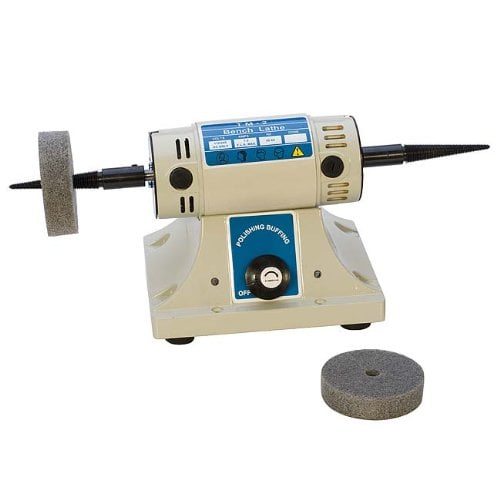Which Polishing Machine Do I Buy?
Polishing machines are the final tool needed to complete your jewelry manufacturing venture. We assist you with purchasing one.
2 Minute Read
The final step in jewelry manufacturing is polishing a newly created piece to a mirror-like finish. This is easily done with a motor powered polishing machine. The machine has a motor that turns a polishing wheel, called a wheel buff.
Some polishing machines have two arms since two wheel buffs are needed - one wheel is stiffer and used first and the second wheel is softer and used second. Wheels are usually five to six inches in diameter and are usually made of muslin.
The coarse wheel buff is coated with a tripoli polishing compound and buffs out heavy scratches and tool marks from the jewelry. Don't be too heavy-handed or you will buff out the details in the metal. The softer wheel buff is coated with a rouge polishing compound and polishes the jewelry to a high shine. Use the coarse, tripoli-coated wheel first and the soft, rouge-coated wheel second. Zam silver polishing compound is an excellent choice for strictly silver jewelry.
A felt ring buff is needed to polish the inside of rings.
Scrub the jewelry between each compound used and when finished. Use kitchen ammonia and a toothbrush.
If you polish silver and gold, keep a tripoli wheel buff and rouge wheel buff for each metal as well (four total). Also, keep the wheels of each compound in separate bags so they do not contaminate each other.
Always hold the jewelry away from you, in breakaway grip, and under the wheel rather than on top for better control and for safety reasons. The wheel spins towards you, so holding the jewelry under the wheel results in it being shot backward in the event that the wheel grabs the piece from your hands. Also, when polishing chains, wrap the chain around a cloth-wrapped ruler and then proceed with polishing it. Reverse it to polish the other side.
Using a polishing machine is a dusty and dirty job, so ventilation is important. Many polishing machines come with blowers to capture dust. Rio Grande has a great selection of the very popular Dura-BULL polishing machines on their website. The site has one arm and two arm polishing machines with built-in blowers. They also offer a two-armed polishing machine kit that includes wheels and polishing compounds. The Dura-BULL machines are expensive, but they are compact, well-ventilated, and long-lasting.
Amazon has an inexpensive polishing machine with no blowers, but it does feature two arms. Be prepared for a dusty mess though. Hoods can be purchased that do a fairly good job of catching dust. They are placed behind each wheel. Also, a cardboard box lined with old rags or foam rubber is sufficient for catching dust and jewelry that might get grabbed by the buffing wheels.
You could build your own polishing machine too. You need a motor that runs at 1,725 rpm. You will need tapered spindles to attach to the motor in order to mount the buffing wheels. Know the diameter of the motor before purchasing the spindles. The motor then needs to be mounted securely to a work bench or table.
Dust masks must be worn to protect your lungs. Safety goggles are a must as well.
Jewelry Polishing Machine Kit Recommendations
Buy List
Budget
Budget
Budget
Megan Coward, Graduate Jeweler Gemologist, GIA, Graduate Gemologist
Megan Coward is a graduate of the GIA with Graduate Jeweler Gemologist and Graduate Gemologist accreditations. She has 20+ years in the retail jewelry industry in various roles including as a diamond buyer and gemstone appraiser.
Related Articles
How Are Calipers Used in Jewelry Making?
What are Jeweler’s Bench Pins?
Jeweler’s Workbench Buying Guide
What Kinds of Solder are Used in Jewelry Making?
Latest Articles
800 Years of Mogok: A Celebration in Tenuous Times
What is the Average Gemstone Faceting Yield?
Pyroxmangite Value, Price, and Jewelry Information
How to Identify Emerald Simulants and Synthetics
Never Stop Learning
When you join the IGS community, you get trusted diamond & gemstone information when you need it.
Get Gemology Insights
Get started with the International Gem Society’s free guide to gemstone identification. Join our weekly newsletter & get a free copy of the Gem ID Checklist!
